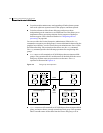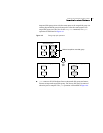
190 Creating and administering disk groups
Handling conflicting configuration copies
You can use the following command to discover the maximum number of
volumes that are supported by VxVM on a Linux host:
# cat /proc/sys/vxvm/vxio/vol_max_volumes
4079
See the vxdg(1M) manual page for more information.
Handling conflicting configuration copies
If an incomplete disk group is imported on several different systems, this can
create inconsistencies in the disk group configuration copies that you may need
to resolve manually. This section and following sections describe how such a
condition can occur, and how to correct it. (When the condition occurs in a
cluster that has been split, it is usually referred to as a serial split brain
condition).
Note: The procedures given here require that the version number of the disk
group is at least 110.
Example of a serial split brain condition in a cluster
Note: This section presents an example of how a serial split brain condition
might occur for a shared disk group in a cluster. For more information about
shared disk groups in clusters, see “Administering cluster functionality” on
page 397. Conflicts between configuration copies can also occur for private disk
groups in clustered and non-clustered configurations where the disk groups
have been partially imported on different systems. The procedure in “Correcting
conflicting configuration information” on page 194 describes how to correct
such problems.
A campus cluster (also known as a stretch cluster or remote mirror
configuration) typically consists of a 2-node cluster where each component
(server, switch and storage) of the cluster exists in a separate building. Figure 4-
1 illustrates a 2-node cluster with node 0, a fibre channel switch and disk
enclosure enc0 in building A, and node 1, another switch and enclosure enc1 in
building B. The fibre channel connectivity is multiply redundant to implement
redundant-loop access between each node and each enclosure. As usual, the two
nodes are also linked by a redundant private network.


















